Appreciate hard work!  Man, you're about to put flame to the foot of a handmade cigar, and for the next hour, enjoy its rich, awe-inspiring smoke. Hold on!
Man, you're about to put flame to the foot of a handmade cigar, and for the next hour, enjoy its rich, awe-inspiring smoke. Hold on!
Yes, you know that it was carefully made by hand, exclusively from tobacco (unlike a cigarette, which includes paper), but do you have any idea how long it took to reach this stage? As you puff, consider the human efforts involved in this $5, $10, or maybe $15 piece of luxury you're enjoying.
As one man said, the best handmade cigars take longer to create than fine automobiles, tailored suits, or even the house in which you live. From seed to smoke, the journey takes several years!
Seeds & Plants -->Growing, Nurturing, & Harvesting --> Curing & Fermentation --> Cigar Rolling --> Packaging, Aging, Shipping --> Marketing
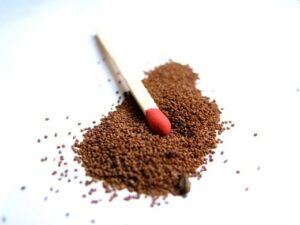 Cigar tobacco starts from tiny seeds, so small that they need to be pelletized, coated with an inert substance such as clay for easier handling (don’t worry, the coating melts away when watered in the ground). Many tobacco growers obtain their seeds by selecting the heartiest plants and harvesting the seeds from the flowers that grow at the top of the plant (see the picture below).
Cigar tobacco starts from tiny seeds, so small that they need to be pelletized, coated with an inert substance such as clay for easier handling (don’t worry, the coating melts away when watered in the ground). Many tobacco growers obtain their seeds by selecting the heartiest plants and harvesting the seeds from the flowers that grow at the top of the plant (see the picture below).
Each selected seed is a proprietary secret of the tobacco company, and therefore, they are locked in safes. Otherwise, they could be stolen, as was once done in Cuba when Castro came to power. Many tobacco growers fled to Nicaragua, Honduras, and the Dominican Republic, taking the tobacco seeds in jars with them.
When the seeds are planted, in about two months, a seed will turn into a seedling, a few inches tall, ready to be planted directly in the ground.
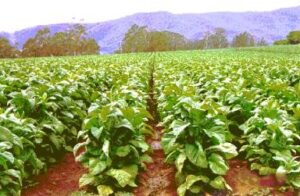 At the next stage, cigar tobacco grows very fast, thanks to the climate and watering. It takes approximately two months for a seedling to grow into a mature plant. Once harvested, it spends another 40 to 60 days in a curing barn – a large warehouse.
At the next stage, cigar tobacco grows very fast, thanks to the climate and watering. It takes approximately two months for a seedling to grow into a mature plant. Once harvested, it spends another 40 to 60 days in a curing barn – a large warehouse.
What comes next? The fermenting and aging. Yes, indeed! The leaves need to age. If you think that everything is so scheduled and pre-determined, you are wrong. Here comes the similarity with the growing grapes to produce wines. The time to harvest the leaves varies significantly depending on the type of tobacco, weather conditions, and numerous other factors. Everything is carefully considered, and the leaves are being carefully examined. You have to be a master of this craft to know when to harvest the tobacco leaves.
There is a lot of manual work in between. After being planted, the plants are usually fertilized with a granular fertilizer once a week. The fields are hoed by hand, a very labor-intensive process in which the fertilizer is mixed with the earth and pulled toward the plant.
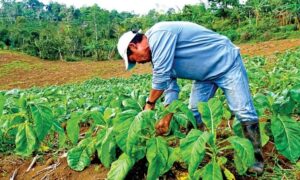 At about the one-month stage—halfway through the growing process—Connecticut-shade plants are still short, perhaps halfway up a tall man's knee, and it's time to tie them to support.
At about the one-month stage—halfway through the growing process—Connecticut-shade plants are still short, perhaps halfway up a tall man's knee, and it's time to tie them to support.
Workers tie a piece of string to the plant and then attach it to another string above to help it grow straight (I grow cucumbers the same way in my garden!). Then they remove by hand the lowest group of leaves on the plant, as well as any suckers -- the excess vegetation that grows above the tobacco leaves. After the leaves are removed, the field is hoed to push the soil above the nodes created by the leaf removal.
In the second month of life, the plant grows at full speed, and it can produce 2 inches in one hot and humid night. About four months after its start as a tobacco seed, the tobacco plants are fully grown, and the leaves have matured.
How tall are they growing?
- A broadleaf plant is waist-high
- Cuban seed is about 6 feet tall
- Connecticut shade or Ecuador Connecticut is higher than 9 or 10 feet
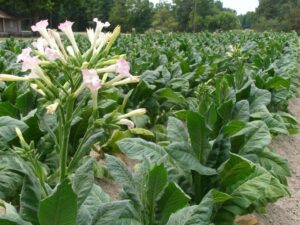 When it's time to prime or to reap, Cuban and Connecticut-seed tobacco plants are harvested by removing three leaves, working from the bottom up.
When it's time to prime or to reap, Cuban and Connecticut-seed tobacco plants are harvested by removing three leaves, working from the bottom up.
Primed leaves are put onto lathes, or cujes, and hung in the barns. The entire plant is hacked with axes, allowed to wither in the sun, then speared on a lathe.
Whether it's primed or cut, the tobacco next goes to the same place: a curing barn, where it will spend about a month drying and turn from a verdant green into a rich brown (see the picture below).
Cured cigar tobacco looks attractive, but it's hardly ready to smoke due to ammonia and other impurities that would make even the most die-hard smokers dizzy in the head if they were to smoke such leaf. To remove impurities and develop the hidden richness of the leaf, cigar tobacco requires fermentation.
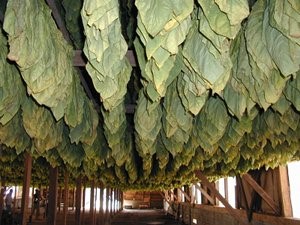 Fermenting tobacco—or working it, as tobacco men say—takes 50% artistry and 50% science. Workers take cured tobacco leaves and lay them on a platform, building waist-high piles known as pilons, or bulks, that can contain thousands of leaves.
Fermenting tobacco—or working it, as tobacco men say—takes 50% artistry and 50% science. Workers take cured tobacco leaves and lay them on a platform, building waist-high piles known as pilons, or bulks, that can contain thousands of leaves.
The leaves contain water, and the pressure of the pile—which can weigh up to 5,000 pounds—creates heat, which transforms the properties of the leaf. I would not walk into a room where fresh tobacco is being fermented – I would rather save my eyes, due to the ammonia coming off the bulks.
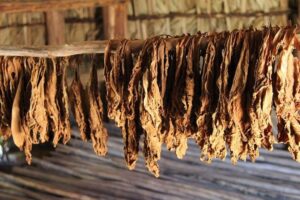 Fermentation can be quick or lengthy, depending on the type of leaf being worked with. Thin, mild leaves, such as those found in Connecticut shade, undergo the process in a few months. Once the tobacco is dry, it no longer ferments. Inside the bale, the tobacco will age, slowly maturing and mellowing the flavors.
Fermentation can be quick or lengthy, depending on the type of leaf being worked with. Thin, mild leaves, such as those found in Connecticut shade, undergo the process in a few months. Once the tobacco is dry, it no longer ferments. Inside the bale, the tobacco will age, slowly maturing and mellowing the flavors.
Achieving the desired color of the wrapper is also part of the fermentation and curing process. The higher the fermentation temperature and the longer the fermentation time, the darker the leaf becomes. Due to its thickness, the most commonly used Maduro wrapper, Connecticut Broadleaf, must be fermented at a temperature of at least 165°F, noticeably higher than that of most wrappers' leaves.
No tobacco can be fermented continuously for five years, not even broadleaf, but it can be aged for that long, and much longer. Aging, which follows fermentation, occurs with much lower levels of humidity and in smaller packages, minimizing the heat created from the combination of moisture and pressure.
There are several brand-name cigar makers, such as Padrón, Fuente, Altadis, General Cigar, Matasa, and Davidoff, among others, that have warehouses filled with tobacco bales. The stocks are essential for the continuous sale of cigars that are expected to maintain consistent taste and flavor even after 2-3 years on the market.
All cigar-makers are blenders, much like the makers of wine, whiskey, bourbon, and cognac, and therefore the same brand of cigars is expected to maintain a consistency of flavor. So, the large bales of tobacco leaves are a necessity,
The piles of tobacco leaves are either processed in the same factory or shipped to specialized facilities that focus on aging and rolling cigars. These facilities may also roll cigars for several tobacco leaf growers. I was lucky to attend one of those places. However, to read about my experience, you will need to open another article (still in the works).
